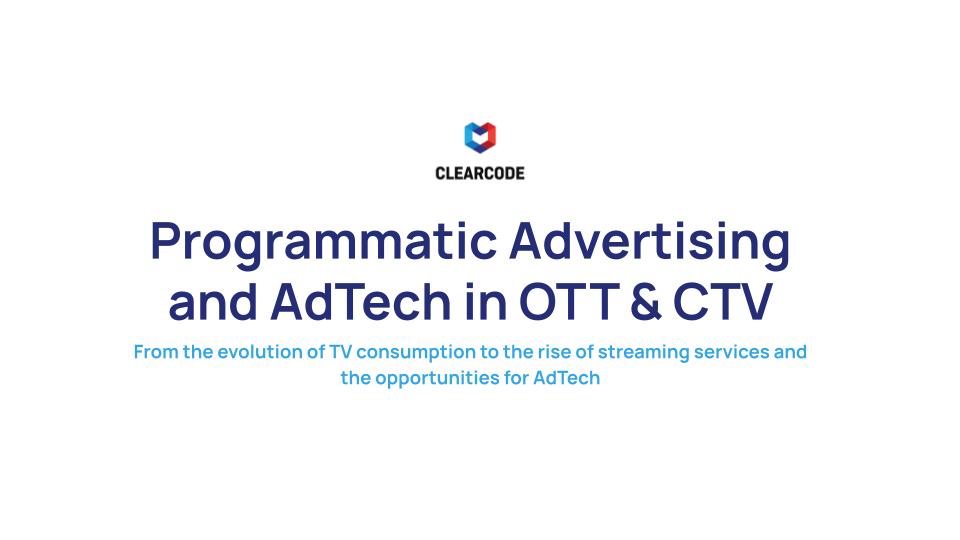The way TV shows, movies, documentaries and sports are consumed has changed a lot over the past 30 years.
The introduction of pay-per-view, VHS, video on demand, DVDs, and digital video recorders (DVRs) have allowed consumers to view video content at a time that suits them — rather than having to wait for the programs to air on linear TV.
Thanks to the introduction and rise of streaming services, consumers yet again have another way to watch their favorite programs.
And this new form of TV consumption has also brought with it new advertising opportunities.
In the presentation below, we cover the following topics:
- The evolution of TV consumption.
- The streaming services landscape.
- CTV usage.
- Streaming services: OTT and CTV.
- OTT & CTV advertising and statistics.
- AdTech’s role in OTT & CTV.
- The challenges facing the OTT and CTV advertising industry.
- Clearcode’s OTT & CTV advertising development projects.
Click on the image below to view the full presentation (instant access — no download required).

The Contents of the Presentation
The Evolution of TV Consumption
Below is a timeline stating when the various forms of TV consumption were introduced.
1930s: Linear TV
1976: VHS
1985: Pay-per-view
1990: Video on demand
1996: DVDs
1999: Digital video recorder (DVR)
2005: Video-streaming services
Key terms
Linear TV: Viewers have to consume TV content at a given time. Examples include free-to-air, cable, satellite, and broadcast.
Pay-per-view: Viewers pay to watch a specific program, e.g. a boxing match.
VHS: Viewers can watch TV content on VHS tapes via a VHS player.
Video on demand: Viewers can watch TV shows and movies when they like.
DVDs: Viewers buy or rent TV shows and movies on DVD.
Digital video recorder (DVR): Viewers can record TV shows and movies and watch them later.
Streaming services: Viewers can watch live sports, TV shows and movies via the Internet.
Streaming Services: OTT and CTV
Streaming services, such as Netflix, Disney+, Hulu, Prime Video, etc. are referred to as over-the-top (OTT) media services. Many OTT media services are viewed on a connected TV (CTV) device.
OTT refers to the video content offered by streaming services. These streaming services can be accessed via CTV devices, as well as desktops, laptops, smartphones, and tablets.
Connected TV (CTV) refers to the devices used to view video content. Examples of CTV devices include smart TVs, streaming devices, and game consoles. Desktops, laptops, smartphones, and tablets aren’t considered examples of CTV by the IAB Tech Lab.
The Streaming-Services Landscape
Today, there are tens of dozens of streaming services offering viewers access to TV shows, movies, documentaries and sport.
These are the main companies providing streaming services:
- Netflix
- Disney+
- Amazon Prime Video
- Paramount+
- Hulu
- Apple TV
- Discovery+
- ESPN+
- Peacock
- BritBox
- HBO Max
- Roku
- Zee5
- YouTube Premium
- RakutenTV
- SHOWTIME
- Curiosity Stream
OTT & CTV Advertising
Advertising has played a key role in helping various forms of media monetize their content and audiences, from newspapers and magazines to websites and mobile apps.
Due to the rise of streaming services, advertising is starting to play a key role in the OTT and CTV industries.
While many streaming services started off as paid subscription-only services, many have adopted an ad-supported subscription model.
Key terms
Subscription Video On Demand (SVOD): A subscription service where consumers pay a certain amount, usually monthly, to view the content.
Ad-Supported Video On Demand (AVOD): A subscription service where consumers don’t pay, or pay less, to view the content but are shown ads.
Many streaming services offer both SVOD and AVOD plans.
A Tale of Two Streaming Services
The two biggest streaming services, Netflix and Hulu, in the future will have similar offerings but their revenue differs greatly.
Netflix:
- Currently offers just SVOD plans but will be offering AVOD plans in the near future to make up for lost subscriber revenue.
- Netflix’s revenue in 2021 was USD $29.7 billion.
Hulu:
- Hulu’s total revenue in 2020 was USD $7.2 billion.
- Hulu’s ad revenue was USD $2.1 billion in the year leading up to September 2021.
The Main Trends in OTT & CTV Advertising
These are the main trends in OTT and CTV advertising:
- More viewers are turning away from traditional TV and towards streaming services.
- Ad spend on linear TV still dwarfs that of CTV, but ad spend on CTV and OTT is increasing, while ad spend on linear TV is decreasing.
- Many streaming services that have traditionally offered only paid subscription plans are adding ad-funded subscription plans to help increase subscription numbers and revenue lost from declining subscriptions.
AdTech’s Role in OTT & CTV
As OTT and CTV advertising continues to rise, the need to build new technologies grows.
Luckily, many of the key digital advertising processes needed to power OTT & CTV advertising can be powered by the existing AdTech infrastructure.
Just like in other channels, AdTech platforms in OTT and CTV advertising are responsible for:
- Ad serving: There are different ways to serve ads in the OTT and CTV environments, e.g. client-side ad insertion (CSAI) and server-side ad insertion (SSAI).
- Media buying: Because OTT and CTV inventory is more premium than other types (e.g. display), the most common media-buying models are direct and private marketplace (PMP).
- Data and measurement: Collecting and using data for OTT and CTV is more challenging than in other channels, e.g. web browsers. Measuring the performance of ads is also more challenging as some viewers may see an ad on CTV but then complete the conversion (e.g. a purchase) on a smartphone.
The Main AdTech Companies in the CTV & OTT Space
These are the main AdTech players in the CTV and OTT advertising market:
The Challenges Facing the OTT and CTV Advertising Industry
CTV and OTT advertising industry is also challenged by:
- Fragmentation: Fragmentation is a common theme in programmatic advertising and the OTT and CTV industry isn’t immune. For the most part, fragmentation in OTT & CTV refers to the fact that each CTV device has its own hardware and software, meaning they all have their own IDs.
- Identity: In the CTV and OTT environments, there are multiple CTV devices and multiple OTT apps, meaning identifying audiences across all of those devices and apps is a huge challenge.
- Measurement: The lack of consistent IDs, closed-off systems, and the nature of server-side ad insertion (SSAI) make it hard to measure the performance of campaigns and detect invalid traffic.
- Ad fraud: Fraudsters follow the money and there’s a lot of money being poured into OTT and CTV. The fact that it’s still in its infancy also means that detecting certain types of ad fraud is often harder than in other channels.








